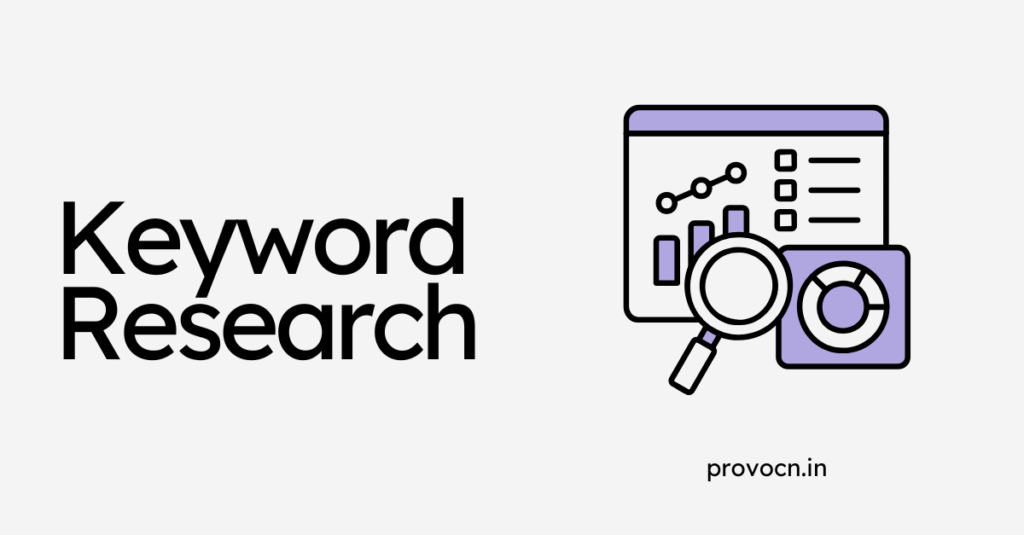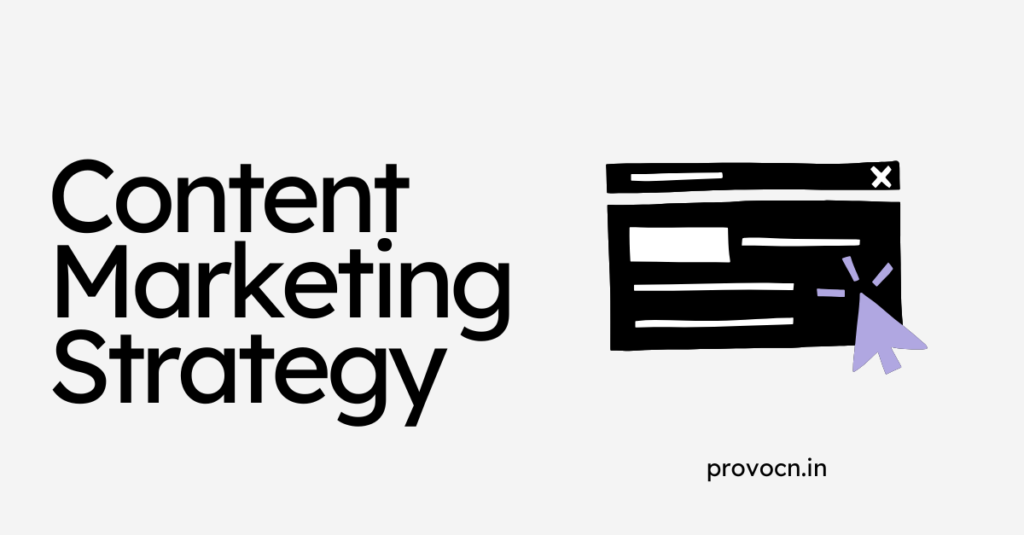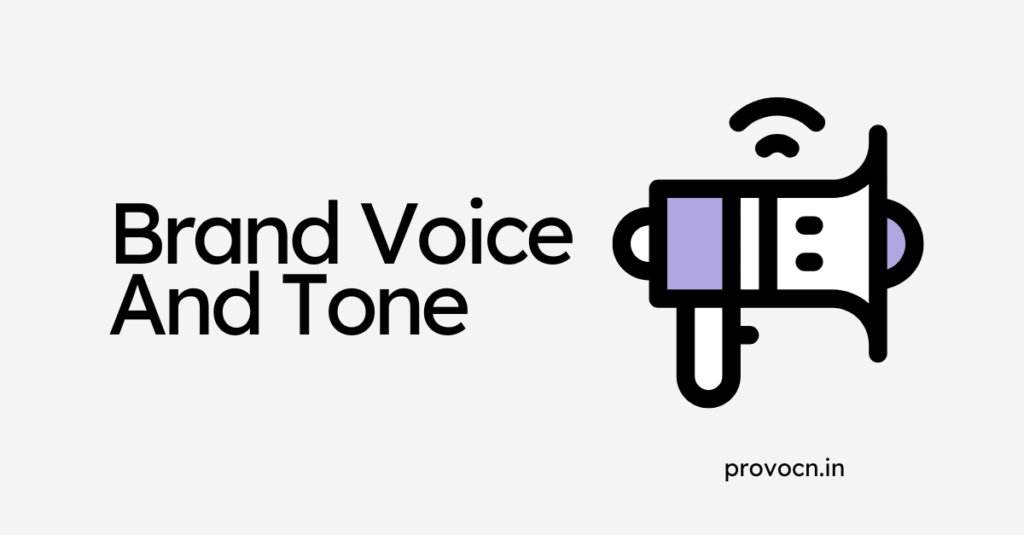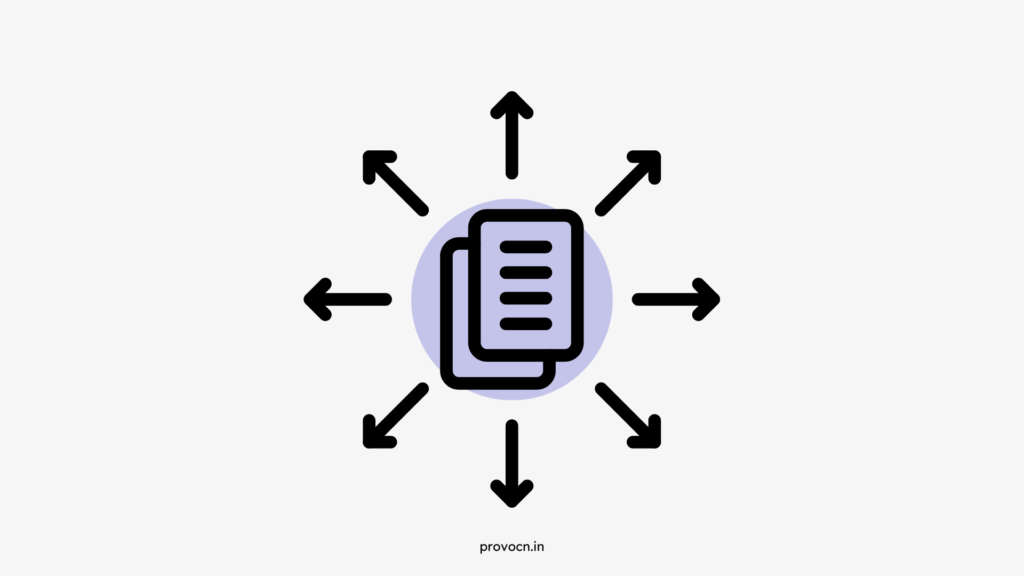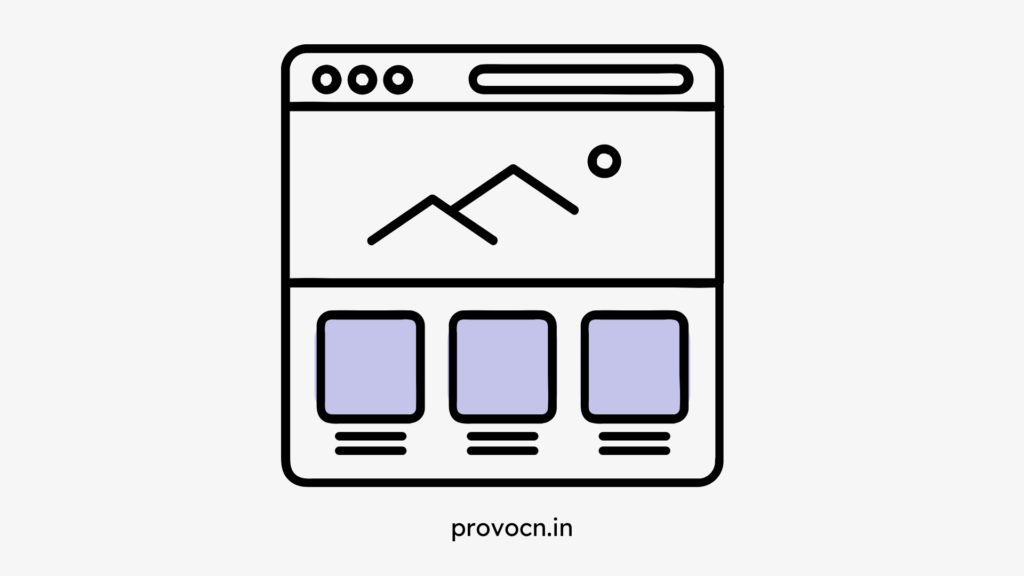How to Create Your Buyer Persona?
Published on January 8, 2025 by Anisha Patel
If your run any business, you need buyer persona. Especially if you are struggling to connect with your ideal customers and your marketing efforts aren’t giving you the results.
A detailed buyer persona is powerful tool that helps you understand your audience and their preferences. So, you can tailor your marketing and business strategies to their liking and increase your revenue.
If you’re a new business owner or existing one without a buyer persona, this blog is for you. First, we’ll understand what is buyer persona, what its benefits are and then lean how to build one for your business.
What Is A Buyer Persona?
A buyer persona is a detailed representation of your ideal customer. It is created by using market research, real customer data, and insights.
It helps you understand your target audience better so that you can tailor your content, messaging and overall marketing strategies to meet their needs, preferences, and challenges.
A lot of marketing efforts get wasted. Having a good buyer persona will help you reduces the wastage and get best out of your efforts.
Almost every business can benefit from developing buyer personas, but they are especially crucial for businesses that rely on a deep understanding of their target audience to drive growth.
Here are some examples of businesses where buyer personas are particularly important:
| B2B Business | B2C Business |
| B2B sales cycles are often long and involve multiple stakeholders. Understanding buyer needs, decision-making processes, and pain points is critical. | Consumer buying behaviours are diverse and vary based on demographic, psychographic, and cultural factors. |
Benefits Of Buyer Persona
Creating a buyer persona offers several benefits. Some of them are:
- Improved Targeting: Buyer personas help you tailor your marketing efforts to specific groups, ensuring that content, messaging, and offers align with the right people.
- Enhanced Content Strategy: By understanding the interests, pain points, and needs of your target audience, you can create more relevant and engaging content that drives action.
- Better Customer Relationships: Buyer persona provide insights into how your customers think and behave, allowing you to build stronger relationships with them.
- Increased Conversions: By creating marketing strategies and content aligned with your buyer persona you can increase overall conversions.
Elements Of Buyer Persona
- 1. Demographics
- 2. Psychographics
- 3. Professional details
- 4. Behavioural insights
- 5. Pain points
- 6. Motivations
- 7. Objections
The buyer persona consists of 7 key elements. Let’s discuss each in detail.
1. Demographics: Demographics are basic characteristics that helps in categorising a specific group of people. It gives you a clear picture of who your audience is and helps you in tailoring your products, services and marketing. The parameters used in demographics are:
- Age
- Gender
- Location
- Income level
- Education
- Marital Status
2. Psychographics: It involves the psychological and emotional aspects of your audience. Unlike demographics, which focus on external characteristics, psychographics focus on the internal motivations, beliefs, and behaviours that are involved in decision-making. The parameters used are:
- Value
- Attitudes
- Personality traits
- Interests
3. Professional Details: Professional details provide insights into your target audience’s work-related characteristics, helping you tailor your product or service to meet their specific career-oriented needs. The parameters used are:
- Industry
- Age
- Gender
- Educational level
- Location
- Income level
- Job title/role
- Work challenges
- Goals and KPIs
4. Behavioural Insights: Behavioural insights focus on understanding how your audience acts, makes decisions, and interacts with content or platforms. These insights allow you to align your strategies with audience behaviours and improve the effectiveness of marketing, sales, and customer engagement efforts.
- Buying pattern
- Decision-making process
- Preferred content formats
- Platforms they engage with
5. Pain Points: Pain points are the specific problems or challenges that your target audience is experiencing. These issues represent unmet needs or frustrations that your product or service can solve. Some examples of pain points are:
- Financial pain points
- Productivity pain pints
- Process pain points
- Support pain points
- Emotional pain points
6. Motivations: Motivations refer to the reasons or driving forces that prompt a person to choose your product or service over others. Understanding these motivations helps you position your offering in a way that resonates with your audience’s core desires and needs. Some examples of motivations are:
- Cost savings
- Saving time
- Convenience
- Trust and reliability
- Social status or image
- Emotional satisfaction
7. Objections: Objections are the concerns, doubts, or reasons for hesitation that potential customers express when considering whether or not to purchase a product or service. Understanding objections is crucial because they can reveal the barriers or mental blocks that prevent a sale. Some examples of objections are:
- Price objections
- Need objections
- Trust objections
- Lack of information objectives
- Risk objections
- Competitor objections
Now you understand what a buyer persona is, what its benefits are and the elements of it. Let’s learn how to build one for your business:
How To Build Buyer Persona?
- Step 1: Define your goals
- Step 2: Gather data
- Step 3: Segment your audience
- Step 4: Identify key information for each persona
- Step 5: Develop the persona profile
- Step 6: Validate the persona
- Step 7: Update regularly
This 7-step process will help you create a buyer persona.
Step 1: Define Your Goals
First you need to have clear goals. Without clarity, the process of developing a persona can become confusing or overwhelming. You can try answering these questions.
- What specific business challenge are we trying to solve with this persona?
- How will this persona align with our broader business objectives?
- What actionable insights do we need from this persona?
- Which teams or departments will benefit from the persona and how?
- What metrics or outcomes will indicate that the persona is effective?
This will help you avoid wasting time and resources on irrelevant details and ensure that the persona you will be creating will be useful to your business.
Step 2: Gather Data
Next we need data. A lot of data. And to gather data for your buyer persona you can use a combination of qualitative and quantitative methods.
Quantitative Data:
By focusing on measurable data you can identify patterns and trends in customer behaviour.
1. Website Analytics: Use tools like Google Analytics to gather insights about your audience, such as:
- Demographics (age, gender, location).
- Behaviour (pages visited, time spent, bounce rates).
- Traffic sources (organic search, referrals, paid ads).
2. Email and CRM Data: Analyze customer data from your email marketing platform or CRM. Look at:
- Purchase history.
- Engagement metrics (click-through rates, open rates).
- Demographics and behavioural patterns.
3. Customer Surveys with Quantifiable Results: Create multiple-choice or scale-based surveys to gather structured data.
Example: Rate the importance of the following features on a scale of 1 to 5.
4. Social Media Analytics: Use tools like Meta Insights, LinkedIn Analytics, or Twitter Analytics to assess your audience’s interests, demographics, and engagement patterns.
5. Industry Reports and Market Research: Refer to third-party market research or industry reports to gain additional data on trends, customer preferences, and behaviors within your niche.
Qualitative Data
These methods will help you focus on finding motivations, emotions, and behaviours to provide detailed and nuanced data.
1. Interviews and Focus Groups:
- Conduct customer interviews: Speak to existing customers directly to learn about their goals, pain points, and buying decisions.
- Host focus groups: Bring together a small group of target customers to discuss their experiences with your brand or industry.
2. Open-Ended Surveys: Use surveys with open-ended questions to allow respondents to elaborate on their answers.
For example: What challenges do you face when [related to your product/service]?
3. Customer Service and Sales Feedback: Talk to your sales reps and customer service teams who interact with customers regularly and gather inputs. They can share insights into customer concerns, objections, and frequently asked questions.
4. Social Listening: Analyze conversations and reviews on social media, forums, or communities relevant to your product or service. Look for repeating things.
5. Competitor Research: Study competitor reviews or case studies to learn how their audience responds to their products and services.
After collecting enough data, lets move to the third step.
Step 3: Segment Your Audience
Organise your customers by identifying common traits. Such as demographics, behaviours, or interests. Look for patterns or trends within these groups that reveal shared characteristics or needs.
This segmentation helps you segment your audience into distinct groups, making it easier to tailor your messaging, products, or services to meet the specific demands of each segment effectively.
Step 4: Identify Key Information for Each Persona
Let’s create a template now. Answering these questions will help you:
1. Demographics: Age, gender, location, income, education level.
- What is the age range of our customers?
- What are their common locations (city, state, region)?
- What is their average income level or socioeconomic status?
- What are their education levels?
- What is their marital or family status (e.g., single, married, parents)?
2. Psychographics: Values, hobbies, personality traits, interests.
- How do they typically interact with our product or service?
- What are their preferred channels for communication and purchasing?
- What factors influence their buying decisions (price, reviews, brand reputation)?
- Are there specific times or seasons when they engage more with our brand?
3. Professional Details: Job title, industry, company size, career goals.
- What job titles or roles do our customers typically hold, and how do these positions relate to our product or service?
- What industries do our customers work in, and how do industry-specific needs influence their decision to engage with us?
- What size companies do our customers work for (small businesses, mid-sized firms, enterprises), and how does this impact their purchasing power or priorities?
- What are our customers’ short-term and long-term career goals, and how can we position our product to help them achieve these goals?
4. Behavioural Insights: Buying pattern, decision making process, preferred content.
- What are the common buying patterns among our customers?
- How do our customers make decisions? Do they rely on thorough research, recommendations, or impulse buying?
- What types of content do our customers engage with most during the buying process (blogs, videos, case studies)?
- What specific steps do our customers take from awareness to purchase, and how long is their decision-making process?
5. Pain Points: Challenges, frustrations, obstacles they face.
- What are the biggest challenges or obstacles our customers face in their daily lives or work?
- What frustrations do they experience with current solutions, and how can we address these shortcomings?
- Are there external factors (time constraints, budget limitations, lack of resources) that prevent them from achieving their goals?
6. Motivations: Convenience, status, cost-effectiveness
- What factors are most important to our customers when deciding to purchase?
- What specific outcomes do our customers hope to achieve by using our product or service?
- How do different audience segments prioritise motivations like convenience, cost-effectiveness, and status in their buying journey?
7. Objections: Price, time, trust
- What are the most common reasons customers hesitate or decide not to purchase from us?
- How do different audience segments perceive our product’s value, and what concerns do they express during the decision-making process?
- What specific objections have our sales or customer service teams encountered when engaging with potential customers.
Step 5: Develop the Persona Profile
Now combine everything and develop your buyer persona. Add a fictional name and use a stock image.
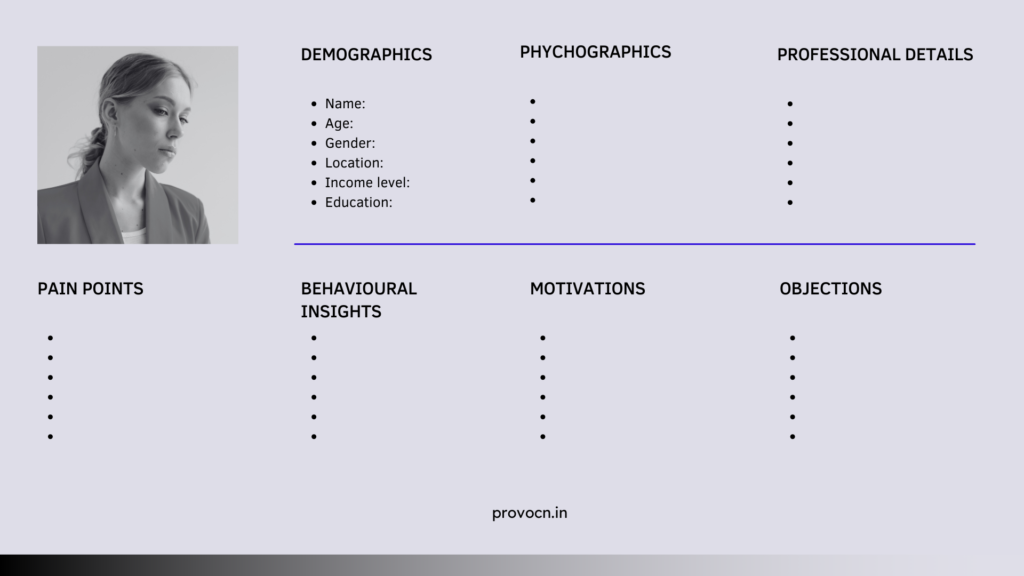
Step 6: Validate the Persona
Once the persona is created, share it with internal teams, such as sales, marketing, and product development. Ask them to give their feedback. Gather the feedbacks and ensure it aligns with real-world interactions and observations with your customers.
Next, test the accuracy of the persona by running campaigns and creating content tailored to the buyer persona you created. Monitor and measure the results.
And do the required changes till it completely align with your business and gives you measurable results.
Step 7: Update Regularly
Market and customer preference keeps changing. It’s important to revisit and refine your buyer persona routinely. By staying updated with changes in customer behaviour, emerging trends, and feedback from internal teams, you can ensure that your buyer persona remains accurate and relevant.
Regular updates will help you stay aligned with evolving customer needs and ensure your marketing strategies continue to resonate with the right audience and your efforts don’t get wasted.
Examples of Buyer Persona
Here are the two most common examples of buyer persona. You can get help from these to create your own buyer persona.
Example 1: B2B Buyer Persona
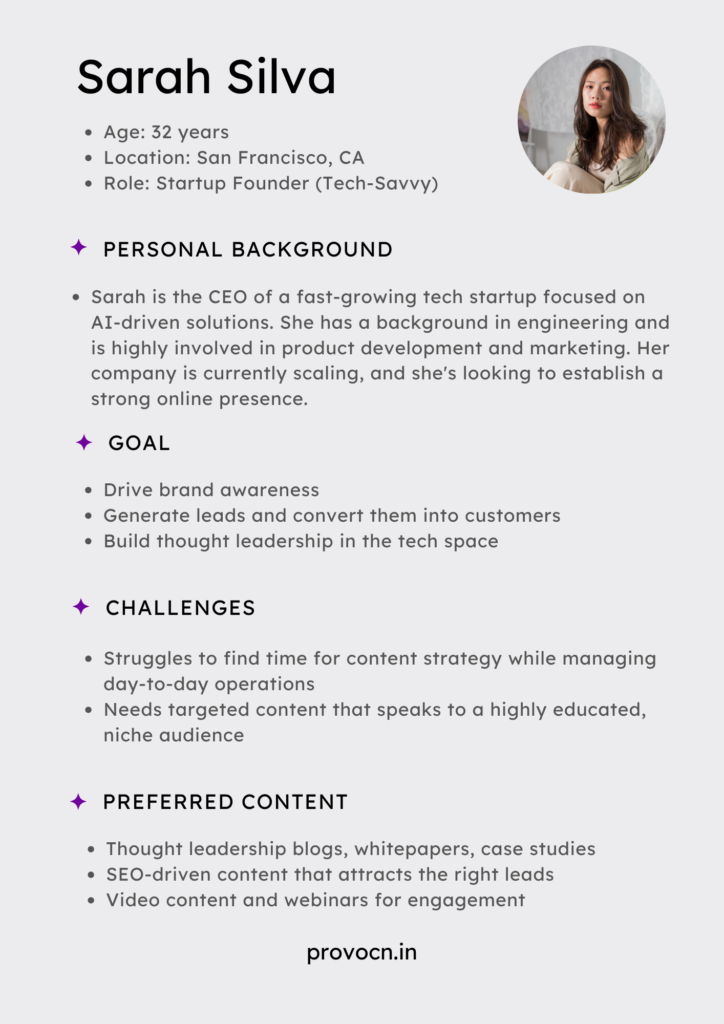
Example 2: B2C Buyer Persona
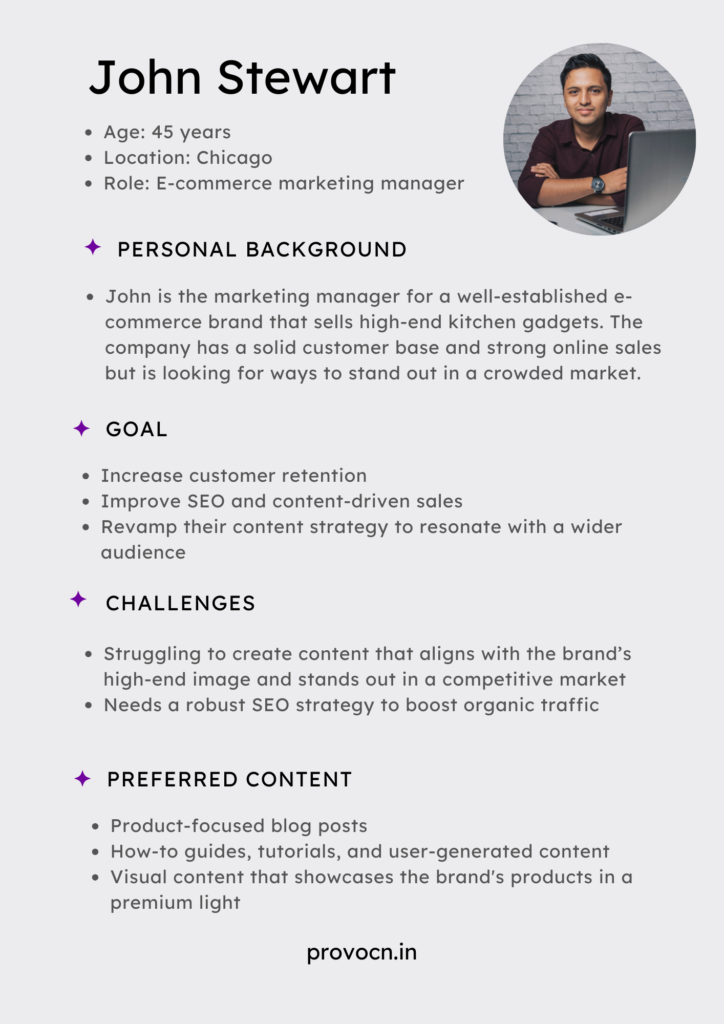
Final words
Creating a buyer persona is an important step that you can take for your business. It can shape the overall strategy and direction of your business.
By clearly defining your ideal customer, you gain invaluable insights into their needs, preferences, and behaviours, which allows you to tailor every aspect of your business to meet their expectations. But it doesn’t end once you’ve created your persona.
It’s important to continuously analyse and refine your buyer persona over time. As markets evolve, so do your customers’ needs and behaviors. Regularly revisiting and updating your persona ensures that your business stays aligned with these changes,
When done right, a well-crafted and continuously refined buyer persona becomes a powerful tool, driving better decision-making, improved customer experiences, and, ultimately, greater business success.

